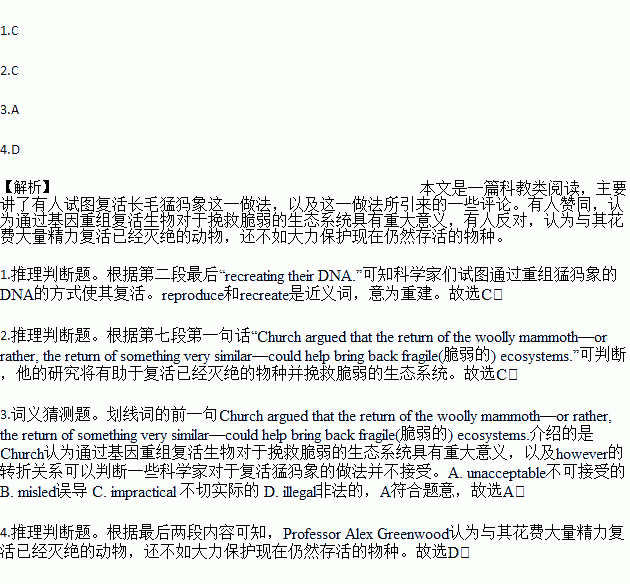题目内容
Many of us remember being in awe(敬畏) when we saw cloned dinosaurs running wild in the film Jurassic Park. And the idea of using technology to revive(恢复) extinct species has long fascinated not only writers and directors, but scientists as well.
According to The Telegraph, woolly mammoths(长毛猛犸象), which featured in the popular Ice Age animated movie series, “may walk the earth once more” now that scientists have taken another step toward realizing a long-held dream—recreating their DNA.
Mammoths became extinct around 10,000 years ago. However, since the discovery of near-perfect preserved remains in Arctic permafrost(北极冻土带) in May 2013, a variety of research studies have been carried out since.
Geneticists from Harvard University analyzed DNA from the remains, looking for genes which separated mammoths from elephants, such as hairiness and ear size. They then used the results to reproduce exact copies of 14 mammoth genes. “It is the first time that mammoth genes have been alive—although so far it has only been done in the lab,” George Church, lead researcher of the project, told the Sunday Times.
Church then used a new technique which allows scientists to edit DNA carefully, replacing sections of elephant DNA with the mammoth genes. So “we now have functioning elephant cells with mammoth DNA in them,” he said.
However, Church ruled out the possibility of bringing the mammoths back to life via cloning from frozen remains. He said he “preferred to focus on rebuilding the full mammoth genome(基因组) by analyzing DNA from preserved remains and putting it into the cells of its closest living relative – the Asian elephant,” reported The Telegraph.
Church argued that the return of the woolly mammoth—or rather, the return of something very similar—could help bring back fragile(脆弱的) ecosystems. However, some scientists believe that bringing back the mammoth would be unethical.
Professor Alex Greenwood, an expert on ancient DNA, said: “We may face the extinction of African and Asian elephants. Why bring back another elephant from extinction when we cannot even keep the ones that are not extinct around?” he told the Sunday Times. “What is the message? We can be as irresponsible with the environment as we want. Then we’ll just clone things back?”
“Money would be better spent focusing on conserving what we do have than spending it on an animal that has been extinct for thousands of years,” he said.
1.We can learn from the article that ______.
A. cloned mammoths followed cloned dinosaurs to get revived
B. the technology to revive mammoth genes is already mature
C. George Church and his colleagues tried to reproduce mammoth DNA
D. Church and his team managed to list all the genes that separate mammoths from elephants
2.According to Church, what is the significance of his study?
A. It could help prevent the extinction of the Asian elephant.
B. It could help people better tell elephant DNA from mammoth genes.
C. It could help bring back some extinct species and save fragile ecosystems.
D. It could help bring mammoths back to life via cloning from frozen remains.
3.The underlined word “unethical” in Paragraph 7 is closest in meaning to ______.
A. unacceptable B. misled
C. impractical D. illegal
4.According to the article, Professor Alex Greenwood believes that _______.
A. there is no need to worry about the extinction of African and Asian elephants at present
B. it’s necessary to bring back species that are beneficial to human beings from extinction
C. the return of the woolly mammoth would help to balance ecosystems
D. it’s more important to protect present species than to bring back extinct ones

